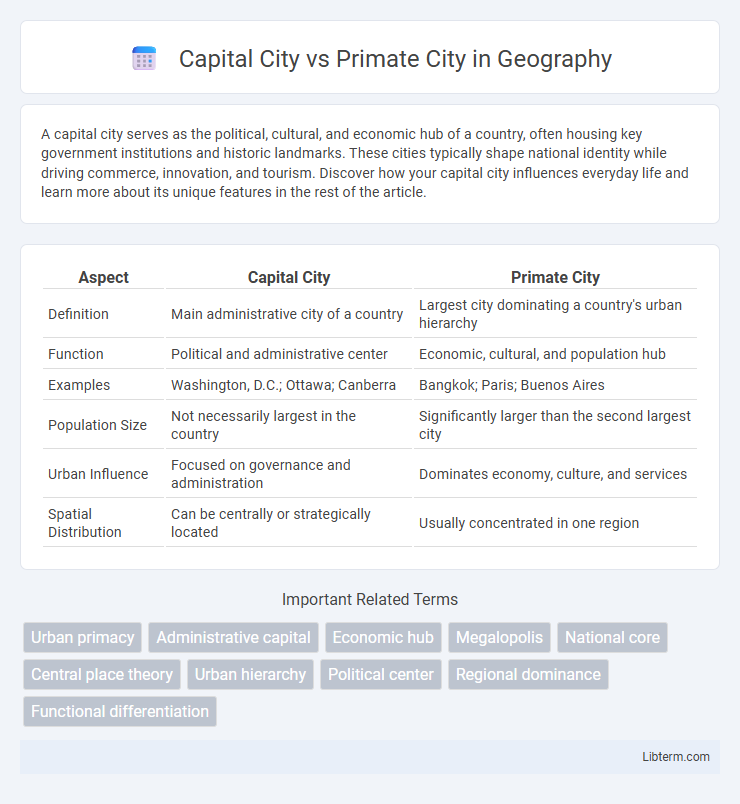A capital city serves as the political, cultural, and economic hub of a country, often housing key government institutions and historic landmarks. These cities typically shape national identity while driving commerce, innovation, and tourism. Discover how your capital city influences everyday life and learn more about its unique features in the rest of the article.
Table of Comparison
| Aspect | Capital City | Primate City |
|---|---|---|
| Definition | Main administrative city of a country | Largest city dominating a country's urban hierarchy |
| Function | Political and administrative center | Economic, cultural, and population hub |
| Examples | Washington, D.C.; Ottawa; Canberra | Bangkok; Paris; Buenos Aires |
| Population Size | Not necessarily largest in the country | Significantly larger than the second largest city |
| Urban Influence | Focused on governance and administration | Dominates economy, culture, and services |
| Spatial Distribution | Can be centrally or strategically located | Usually concentrated in one region |
Defining Capital City and Primate City
A capital city serves as the administrative and political center of a country, housing government institutions and official residences, with examples like Washington, D.C. or Canberra. A primate city is the largest city in its country, significantly larger than any other city, dominating economic, cultural, and political activities, such as Bangkok in Thailand or Mexico City in Mexico. While all capital cities serve governance functions, not all are primate cities, and some primate cities are not capitals.
Historical Contexts of Capital and Primate Cities
Capital cities often emerged due to political, administrative, or strategic significance, serving as seats of government and centers of power within a nation, like Washington, D.C. or Brasilia. Primate cities, such as Bangkok or Mexico City, develop historically as dominant urban centers that concentrate economic, cultural, and demographic functions, surpassing other cities in size and influence. Understanding the distinct historical contexts reveals how capitals are frequently planned or designated, while primate cities evolve organically through trade, colonization, or centralization of resources.
Political Significance: Power and Authority
Capital cities serve as the official seats of government, housing key political institutions, administrative offices, and diplomatic missions that centralize state power and authority. Primate cities, while often being political hubs due to their economic and cultural dominance, may not always contain the primary government functions but still exert significant influence over national decision-making processes. The distinction lies in the capital city's formal political role versus the primate city's concentration of socio-political power within the country's spatial hierarchy.
Economic Impacts and City Dominance
A primate city, often significantly larger and economically dominant compared to other cities in a country, tends to centralize financial resources, government functions, and business activities, leading to pronounced regional disparities. Capital cities, while politically central, may not always exhibit primate city characteristics if economic activities are distributed more evenly across multiple urban areas. The concentration of wealth and services in a primate city can drive national economic growth but may also exacerbate urban congestion, infrastructure strain, and imbalanced regional development.
Cultural and Social Influences
A capital city typically serves as the administrative and political center, fostering diverse cultural institutions like museums, theaters, and government buildings that shape national identity and social cohesion. In contrast, a primate city dominates the country's urban hierarchy, often concentrating economic opportunities, media hubs, and cultural activities that influence social trends and lifestyle choices nationwide. The cultural vibrancy and social dynamics in primate cities tend to overshadow smaller cities, amplifying their role in shaping national culture and social norms.
Urbanization Patterns and Population Distribution
Capital cities typically function as administrative and political hubs, often designed to balance population distribution across a country, while primate cities dominate urbanization patterns with disproportionately large populations and concentrated economic activities. The primate city phenomenon leads to significant rural-to-urban migration, causing uneven urban growth and overwhelming infrastructure in a single dominant city, which contrasts with more evenly spaced capital cities that encourage balanced national development. Population distribution in primate cities is heavily skewed, amplifying urban challenges such as congestion and housing shortages, unlike multi-centered urban systems centered around capital cities.
Advantages and Disadvantages of Primate Cities
Primate cities, such as Bangkok or Mexico City, concentrate economic activities, cultural institutions, and political power, fostering rapid development and efficient resource allocation. This concentration often leads to advantages like enhanced infrastructure, better job opportunities, and global connectivity. However, disadvantages include overcrowding, severe traffic congestion, unequal regional development, and increased vulnerability to economic or environmental shocks concentrated in a single urban area.
Case Studies: Examples from Around the World
Capital cities like Washington D.C., Australia's Canberra, and Brazil's Brasilia are often purpose-built political centers designed to distribute administrative functions strategically. In contrast, primate cities such as Bangkok, Mexico City, and Seoul dominate their countries economically, politically, and culturally, representing a disproportionate concentration of population and resources. Case studies of these urban forms reveal how primate cities can drive national development but also exacerbate regional inequalities, while planned capitals aim to promote balanced growth and political neutrality.
Urban Planning Challenges and Solutions
Capital cities often face unique urban planning challenges due to their administrative functions, high population density, and concentration of economic activities, leading to traffic congestion, inadequate housing, and strained infrastructure. Primate cities, being disproportionately larger and more dominant than other cities in a country, exacerbate regional disparities and overburden urban services, causing challenges in sustainable development and resource allocation. Solutions include decentralizing administrative functions, promoting secondary cities through economic incentives, investing in mass transit systems, and implementing integrated land-use policies to balance growth and enhance livability.
Future Trends in Urban Hierarchies
Primate cities dominate national urban hierarchies due to their disproportionate economic, cultural, and political influence compared to other cities. Future trends indicate increased decentralization with secondary cities gaining prominence through technology-driven economic diversification and improved infrastructure. Urban planners anticipate more balanced development, reducing overconcentration in primate cities while capital cities may maintain administrative centrality but share economic functions with emerging urban centers.
Capital City Infographic

 libterm.com
libterm.com